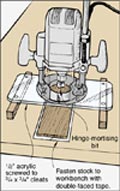|
Router stands in for a surface planer

You need a small piece of thin stock for a project, but not enough to justify the cost of a planer. Or, maybe you have a planer,
but the piece you need to plane down is just too short to run safely through the machine. Are resawing or hand-planing your
only choices? Put your router on the job with an easy-to-build elevated base, shown opposite. Bore a 2" hole through
the center of a piece of clear acrylic plastic or plywood that's as wide as your router's base and about twice as long. Attach
the router over the hole on top of the piece with the handles aligned lengthwise. On the bottom, attach a 3/4x3/4x12"
cleat centered across each end. Fasten the workpiece to a saw table or other flat, smooth surface with double-faced tape.
Use plenty of tape, and tap the face of the wood lightly with a non-marring mallet to ensure a tight bond. Now, with a hinge-mortising
bit in the router, adjust the depth of cut to skim off enough material to leave the thickness you need. If you need to remove
a lot of material, take it off in small increments
Understanding Hinges
Hinge Styles Depend on Cabinet Design
Adding new hardware and hinges is the secret to a spectacular kitchen update. The style of hinge you choose, however,
is dependent upon the type and style of your cabinets. To fit your exact needs, Rockler has a large number of styles from
which to choose. In this article we’ll discuss the options and differences so that you can become "hinge wise,"
and add a dazzling new touch to your cabinetry design.
Step 1: Are your cabinets Face Frame or Frameless?
Frameless CabinetFace Frame CabinetThe style of hinge you choose will be largely determined by how your cabinets are made.
First determine if your cabinet has a face frame or is frameless.
Step 2: Determine the overlay of your doors:
For Face Frame Cabinets:
Most traditional cabinetry will require face frame mounted hinges for doors that overlay their face frames. Overlay is
the relationship of your cabinet doors to the cabinet faces. The amount of overlay will determine the type of hinge you will
need. There are three kinds of face frame overlay:
* Overlay - If your doors completely overlay face frames (lie on top of the cabinet faces), and there is no rabbet
on their back edge, you will need an overlay hinge.
Overlay
* 3/8" Inset Hinge - If your doors partially overlay their face frames and have a rabbet cut along their back
edges, you need a 3/8" inset hinge.
3/8'' Inset Hinge
* Full Inset Hinge - If your door fronts are flush with their face frames and are inset within the frames, you will
need a full inset hinge.
Full Inset
For Frameless Cabinets:
On European style cabinets, hinges are attached directly to the side of the cabinet. The amount of overlay (how far your
doors overlap the cabinet sides) will determine the type of hinge you will need. European cabinets have three kinds of overlay:
* Full Overlay - If your doors completely overlay your cabinet sides (lie completely on top of the cabinet side edges),
you will need a frameless overlay hinge.
* Half Overlay - If your doors partially overlay the side edges of your cabinets (usually about half way), you will
need a frameless half overlay hinge.
* Full Inset - Frameless cabinets with door fronts that are flush with the side edges of cabinet faces and are fully
inset within the side edges will require frameless inset hinges.
Overlay or Inset — what's the difference?
Here's something to consider when selecting hinges
Look at your cabinet design before selecting hinges. On Eurostyle cabinets, hinges are attached directly to the cabinet
side. This gives you the option of fully overlaying, half overlaying or insetting the door within the opening, as shown below.
Overlay applications
If you decide to use an overlay cabinet design, select full overlay hinges for the ends and half overlay hinges in the
middle of a row of cabinets.
Inset applications
Inset doors are recessed into the cabinet carcass to create a completely flush, clean-lined look.
Other Styles and Functions
Rockler has a large selection of additional hinge types available including:
Flipper Door Systems (For sliding, hiding doors)
Clip on Hinges (For wider opening doors)
Cross Corner Hinges (For doors closing at a 45-degree angle)
Fully Concealed Hinges (For doors concealing pull-out shelving)
Surface Mount Hinges
Wraparound Hinges (No mortise for Euro-style applications)
and many more...
How Many Hinges Per Door?
How Many Hinges GraphThe number of hinges you require will be contingent upon the height and weight of your doors. Use
this chart to determine how many hinges you will need. For instance, a 43" high door weighing 14 lbs would require 3
hinges.
Installing Your Hinges
Accuracy is crucial to the successful installation of hinges and to assure proper door alignment. Rockler recommends using
the appropriate installation jig or the guide of your choice. See our line of installation Jig-It's, and self-centering drill
bits for more information.
|

